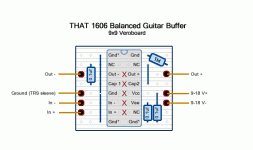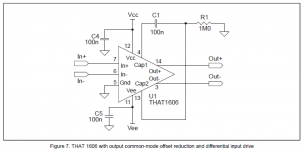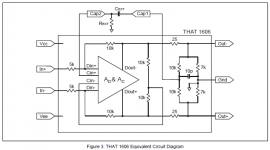Hey guys,
I'm building a balanced in, balanced out line buffer for a guitar onboard preamp. I just need this to provide unity gain buffering with maximum signal to noise.
I decided on using a THAT1606 chip due to its simplicity.
I've attached a sample circuit they include from their pdf on the THAT1606 and a vero board layout for it I designed. Did I screw anything up or should this work okay?
The pinout is as follows:
1 Gnd*
2 NC
3 Out-
4 Cap1
5 Gnd
6 In-
7 In+
8 Gnd*
9 Gnd*
10 NC
11 Vee
12 Vcc
13 Cap2
14 Out+
15 NC
16 Gnd*
Also the THAT1606 pdf says:
"Pins 1, 8, 9, and 16 are fused to the die paddle to assist in conducting heat away from the die. These pins are connected to the die substrate, which is, in turn, connected to the ground pin of the device."
Does this mean pins 1, 8, 9, and 16 are already linked internally and I don't need to link them manually with the two jumpers on the left of the chip?
Thanks for any help. Parts are on the way. I'm looking forward to getting this built and functioning.
I'm building a balanced in, balanced out line buffer for a guitar onboard preamp. I just need this to provide unity gain buffering with maximum signal to noise.
I decided on using a THAT1606 chip due to its simplicity.
I've attached a sample circuit they include from their pdf on the THAT1606 and a vero board layout for it I designed. Did I screw anything up or should this work okay?
The pinout is as follows:
1 Gnd*
2 NC
3 Out-
4 Cap1
5 Gnd
6 In-
7 In+
8 Gnd*
9 Gnd*
10 NC
11 Vee
12 Vcc
13 Cap2
14 Out+
15 NC
16 Gnd*
Also the THAT1606 pdf says:
"Pins 1, 8, 9, and 16 are fused to the die paddle to assist in conducting heat away from the die. These pins are connected to the die substrate, which is, in turn, connected to the ground pin of the device."
Does this mean pins 1, 8, 9, and 16 are already linked internally and I don't need to link them manually with the two jumpers on the left of the chip?
Thanks for any help. Parts are on the way. I'm looking forward to getting this built and functioning.
Attachments
Last edited:
Looks reasonable, assuming you're using split supplies (2 9V batteries etc)
Have you considered what path the input bias currents will take? All opamps leak a tiny DC current from their inputs. If you're wiring your pickups balanced, you have to return these bias currents to ground somehow, or the inputs will float away to one of the rails and the circuit won't work.
Have you considered what path the input bias currents will take? All opamps leak a tiny DC current from their inputs. If you're wiring your pickups balanced, you have to return these bias currents to ground somehow, or the inputs will float away to one of the rails and the circuit won't work.
Thanks for the reply. The pdf lists "Power Supply Voltage Range ±4 to ±18" - would a single 9V battery not work as well?Looks reasonable, assuming you're using split supplies (2 9V batteries etc)
Have you considered what path the input bias currents will take? All opamps leak a tiny DC current from their inputs. If you're wiring your pickups balanced, you have to return these bias currents to ground somehow, or the inputs will float away to one of the rails and the circuit won't work.
Is this not integrated into the 1606 design already? I've attached the 1606 equivalent current.
Attachments
Well I finished it and just installed it. Incredibly disappointing.
Scopeboy you were right of course and I needed to use two 9 V batteries to get it working (to generate a dual rail power supply).
The problem is even with that operating as I expect it should the performance is horrible. The sound is dull. It lacks the brightness I usually get from a buffered guitar. The level is low too. It is peaking in my DAW at -8 dB with the guitar volume wide open. Usually a buffered output from my guitar would go to +6 dB or more even unbalanced.
I'm guessing either I did something wrong or the THAT 1606 was for reason I don't understand a poor substitute for a usual guitar opamp buffer circuit.
Can anyone explain why this isn't working right? I'm guessing it has something to do with impedance and signal level of the guitar not being well suited for the THAT1606 input but I don't really know enough electronics theory to understand how/why.
I still want to get my buffered balanced guitar working. Unless someone can suggest an explanation for why the THAT1606 is failing me, I'm ordering one of these: http://www.coldcrafteffects.net/blog/product/micro-buffer-mkii/ and building it as two parallel buffers (one for + and one for - signal).
Damn what a waste of time this has been.
Scopeboy you were right of course and I needed to use two 9 V batteries to get it working (to generate a dual rail power supply).
The problem is even with that operating as I expect it should the performance is horrible. The sound is dull. It lacks the brightness I usually get from a buffered guitar. The level is low too. It is peaking in my DAW at -8 dB with the guitar volume wide open. Usually a buffered output from my guitar would go to +6 dB or more even unbalanced.
I'm guessing either I did something wrong or the THAT 1606 was for reason I don't understand a poor substitute for a usual guitar opamp buffer circuit.
Can anyone explain why this isn't working right? I'm guessing it has something to do with impedance and signal level of the guitar not being well suited for the THAT1606 input but I don't really know enough electronics theory to understand how/why.
I still want to get my buffered balanced guitar working. Unless someone can suggest an explanation for why the THAT1606 is failing me, I'm ordering one of these: http://www.coldcrafteffects.net/blog/product/micro-buffer-mkii/ and building it as two parallel buffers (one for + and one for - signal).
Damn what a waste of time this has been.
Yes, the immediate problem you have is that the THAT1606 datasheet says the input impedance of the opamp is only 4-5 kiloohms. That is literally TWO orders of magnitude too low (I personally will only use FETs or tubes and design for an even higher input impedance than that in the megohm range). So your opamp is loading down the pickups and killing your highs.
You might want to back up and describe what you were trying to achieve. I'm not a fan of nonstandard MI cabling, but I can think of a handful of guitar cabling that would be more useful for making music than a balanced guitar output.
You might want to back up and describe what you were trying to achieve. I'm not a fan of nonstandard MI cabling, but I can think of a handful of guitar cabling that would be more useful for making music than a balanced guitar output.
Yes, the immediate problem you have is that the THAT1606 datasheet says the input impedance of the opamp is only 4-5 kiloohms. That is literally TWO orders of magnitude too low (I personally will only use FETs or tubes and design for an even higher input impedance than that in the megohm range). So your opamp is loading down the pickups and killing your highs.
You might want to back up and describe what you were trying to achieve. I'm not a fan of nonstandard MI cabling, but I can think of a handful of guitar cabling that would be more useful for making music than a balanced guitar output.
Thanks. I should have realized that from the start. Damn. Like I said, what a waste of time.
In any case, I've ordered some PCB's for the dual channel buffer I linked above and that should definitely work since it's designed for guitar pickup impedance.
As for why I'm interested in balanced output guitar, it's a recording guitar. Therefore the highest priority is maximizing signal to noise, so when it's distorted to hell, there's as little noise floor as possible to come up and be audible.
My inspiration was this site which shows leaving pickups balanced (humbuckers are balanced by nature, usual guitar wiring UNbalances them) gives an incredible drop in the noise floor:
Guitar Wiring - Naiant Studio & Musical Imports
An externally hosted image should be here but it was not working when we last tested it.
Now I guess I'll just have to wait until those PCB's arrive, hope they're small enough to fit in my cavity, and try again.

Balanced pickups are only good for rejecting electrostatic interference, the sort that comes in by capacitive coupling. This kind of interference can also be got rid of by shielding and making sure all guitar metalwork is grounded.
You also need to consider interference that is coupled inductively. In other words, induced into the pickup coils just the same as the wanted signal. Humbuckers are already magnetically balanced and will reject this kind of hum even when connected to an unbalanced circuit. Single coils are magnetically unbalanced and will always pick up hum even if the electric circuit is balanced.
You also need to consider interference that is coupled inductively. In other words, induced into the pickup coils just the same as the wanted signal. Humbuckers are already magnetically balanced and will reject this kind of hum even when connected to an unbalanced circuit. Single coils are magnetically unbalanced and will always pick up hum even if the electric circuit is balanced.
Last edited:
Audiovisceral,
Have a look at http://www.diyaudio.com/forums/inst...d-unbalanced-line-receiver-3.html#post3817648
In particular posts 26 (mine) and 36. Use an ina217.
Regards,
Paul Bysouth
Have a look at http://www.diyaudio.com/forums/inst...d-unbalanced-line-receiver-3.html#post3817648
In particular posts 26 (mine) and 36. Use an ina217.
Regards,
Paul Bysouth
- Status
- This old topic is closed. If you want to reopen this topic, contact a moderator using the "Report Post" button.
- Home
- Live Sound
- Instruments and Amps
- THAT1606 based line buffer for balanced guitar - Vero design okay?


